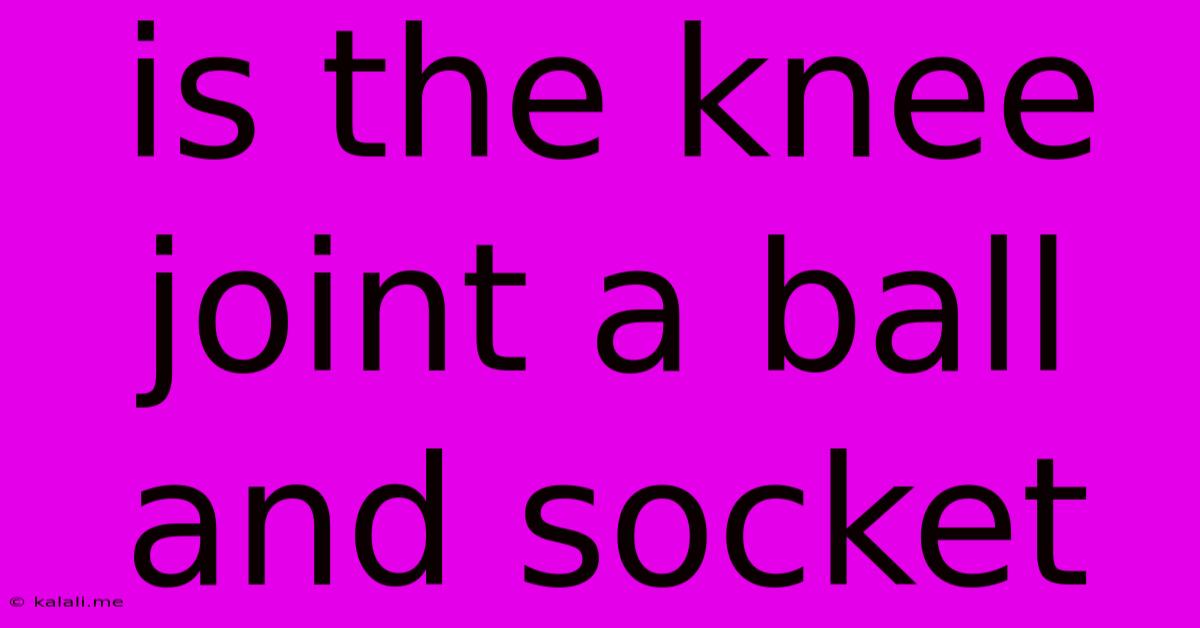Is The Knee Joint A Ball And Socket
Kalali
May 09, 2025 · 3 min read

Table of Contents
Is the Knee Joint a Ball and Socket? Understanding Knee Joint Anatomy
The short answer is no, the knee joint is not a ball and socket joint. This article will delve into the specifics of knee joint anatomy, clarifying its structure and comparing it to true ball and socket joints like the hip and shoulder. Understanding this fundamental difference is crucial for comprehending knee function, potential injuries, and effective treatment.
The knee is a complex hinge joint, allowing primarily for flexion (bending) and extension (straightening) of the leg. Its unique structure contributes to its remarkable stability and load-bearing capacity, despite its comparatively limited range of motion compared to ball and socket joints. Let's explore the key components and why it's structurally different.
Key Components of the Knee Joint
- Femur (Thigh Bone): The distal (lower) end of the femur features two rounded condyles that articulate with the tibia.
- Tibia (Shin Bone): The proximal (upper) end of the tibia has flat articular surfaces, the tibial plateaus, which receive the femoral condyles.
- Patella (Kneecap): This sesamoid bone sits within the quadriceps tendon, improving the leverage of the quadriceps muscle group during knee extension.
- Menisci: Two C-shaped pieces of fibrocartilage, the medial and lateral menisci, act as shock absorbers and improve the congruency of the joint surfaces.
- Ligaments: Crucial for stability, the knee possesses several ligaments, including the anterior cruciate ligament (ACL), posterior cruciate ligament (PCL), medial collateral ligament (MCL), and lateral collateral ligament (LCL). These ligaments prevent excessive movement and provide rotational stability.
- Cartilage: Articular cartilage covers the ends of the bones, providing a smooth, low-friction surface for movement.
Comparing Knee and Ball and Socket Joints
Ball and socket joints, like the hip and shoulder, allow for movement in three planes: flexion and extension, abduction and adduction, and internal and external rotation. This extensive range of motion is a result of the spherical head of one bone fitting into the cup-shaped socket of another.
The knee, on the other hand, is primarily a hinge joint with a limited degree of rotation, particularly when the knee is flexed. The shape of the articulating surfaces – the femoral condyles and tibial plateaus – prevents the significant rotational movement characteristic of ball and socket joints. The intricate system of ligaments further restricts excessive rotation, ensuring joint stability. While some slight rotation is possible, it's far less than the freedom of movement found in ball and socket joints.
Understanding the Importance of this Distinction
Understanding the difference between hinge and ball and socket joints is critical for several reasons:
- Injury Diagnosis: Knowing the knee's structure helps doctors diagnose injuries accurately. For instance, ACL tears are common in sports involving twisting motions, highlighting the knee's relative vulnerability to rotational forces despite its stability.
- Treatment Planning: Treatment plans, including physical therapy and surgical interventions, are tailored to the specific nature of the knee joint.
- Prevention Strategies: Understanding the limitations of the knee joint allows for the development of effective strategies to prevent injury, such as proper warm-up routines and targeted strength training exercises.
In conclusion, the knee joint is a complex and vital structure, but it is fundamentally a hinge joint, not a ball and socket joint. Its unique anatomy allows for efficient weight-bearing and movement while maintaining substantial stability. Recognizing this crucial distinction is essential for understanding knee function, managing injuries, and promoting overall joint health.
Latest Posts
Latest Posts
-
What Is The Greatest Common Factor For 12 And 18
May 09, 2025
-
What Is The Area Of This Composite Figure
May 09, 2025
-
What Are The Multiples Of 48
May 09, 2025
-
How Many Inches Is 29 Centimeters
May 09, 2025
-
4 And 2 3 As An Improper Fraction
May 09, 2025
Related Post
Thank you for visiting our website which covers about Is The Knee Joint A Ball And Socket . We hope the information provided has been useful to you. Feel free to contact us if you have any questions or need further assistance. See you next time and don't miss to bookmark.